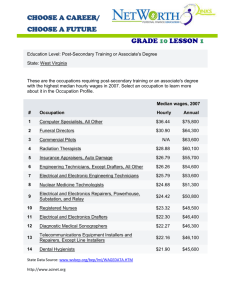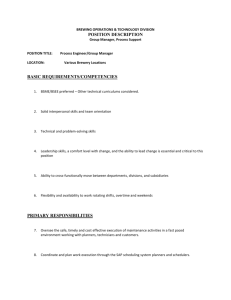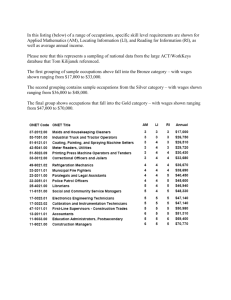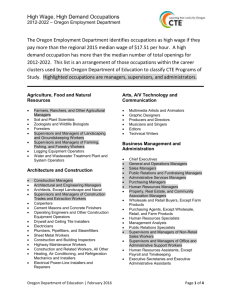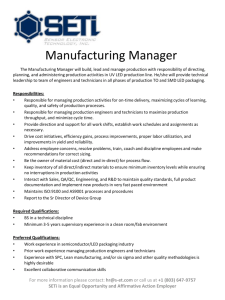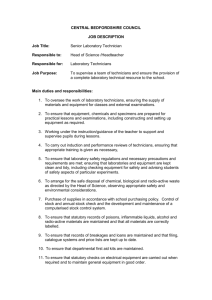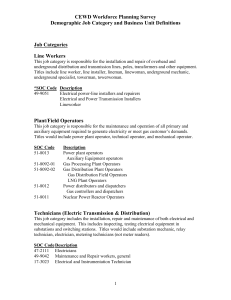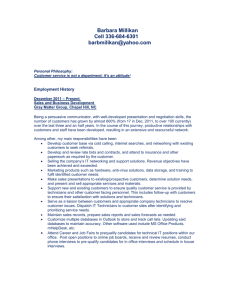PPT - The Skills Library
advertisement
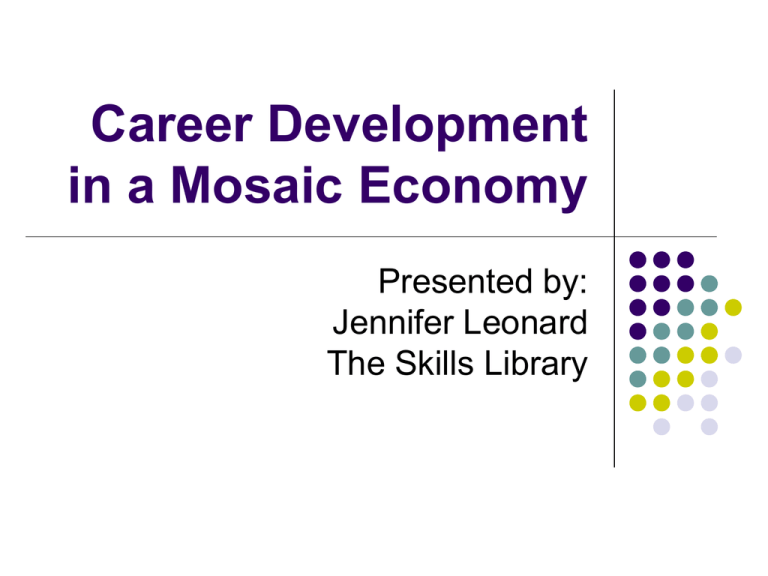
Career Development in a Mosaic Economy Presented by: Jennifer Leonard The Skills Library Agenda • Warm-up exercise: Career Outlook Interview (informational interview) (Use the worksheet to interview someone at your table about their job, or the job of a friend or family member) • Concept of a “Mosaic Economy” • How does this concept apply to your classroom & your students? • Topics to explore (somewhat academic) • Key questions to explore (very practical) Where are the jobs? A dynamic market…. Jobs are not a fixed, limited resource – but are constantly being created in a dynamic labor market. The job market is always evolving, and is an interesting topic to study via statistics, history, economics, science/technology and more. A mosaic of jobs… There is no single, quick answer to the question “where are the jobs?” Instead, the new economy offers a mosaic of diverse career opportunities. … and a variety of career paths. Many (or most) successful careers are shaped gradually over time. While some careers require specific education, training and certification, others require only that you take “first steps” that will lead to interesting career growth. There are a wide variety of jobs available in the current economy with a variety of education and skill requirements – including many technical and middle-skilled jobs that require education and training for less than four years of college and many grow-with-the-company jobs that are attainable from a variety of education backgrounds. A “mosaic” of jobs Farmers’ Market Coordinator Interior Designer Physical Therapist Assistant Medical Supply Salesperson Medical Equipment Repairer Retail Salesperson Hardware Store Solar Product Salesperson Medical Research Community Garden Organizer Home Remodeling Contractor Straight-line paths or not-so-straight Purchasing Manager for Health Care Center Communications Director For Tourism Board Nutritionist for Grocery Store Chain Agricultural Extension Specialist Coordinator for Farmers Markets Solar Panel Installer Landscaper Nurse Dietician A Sense of History.... Economic History Employment by Industry Sector, U.S., 1810-2007 International Comparisons Employment by Industry Sector, U.S., 1810-2007 Current Statistics Current Statistics Mosaic Economy Themes Technology and science – impacting virtually every field Attention to home and personal living and working environments Manufacturing A smaller but resilient manufacturing sector; still an anchor of the economy and a leading source of exports. Concerns for environmental and economic sustainability are part of business and personal career values Revitalization of “traditional” sectors of the economy -- farms, printers, bookstores, publishing, textile mills, sewing, fabric stores Attention to community connectedness Attention to health and wellness Interdependent sectors: manufacturing-sector + service-sector Business-to-business services – engineering, R&D, marketing, accounting, software, repair/maintenance, etc. Economic Statistics: Wages and Education Wages $ % of workers with more than high school Educational Levels and Occupations. Selected Examples Based on Actual Educational Level of Individuals in the Career Field Actual Education Level High Growth Occupations Moderate or Low Growth Occupations High School or Less Including Apprenticeship (over 50% of individuals have high school or less) Bicycle Repairers Childcare Workers Glaziers Home Health Aides Industrial Machinery Mechanics Motorcycle Mechanics Personal Care Aides Stonemasons Bus Drivers Carpenters Forest and Conservation Workers Home Appliance Repairers Light Truck and Delivery Drivers Machinists Maintenance Workers, Machinery 1-3 Years Postsecondary (Over 50% of individuals have 1 to 3 years of postsecondary education) Dental Hygienists Emergency Medical Technicians and Paramedics Environmental Engineering Technicians Medical Equipment Repairers Occupational Therapy Assistants Physical Therapist Assistants Radio, Cellular, and Tower Equipment Installers and Repairers Respiratory Therapists Veterinary Technologists and Technicians Bailiffs Police and Sheriff Patrol Officers Respiratory Therapist Technicians Surveying and Mapping Technicians 4 or More Years College (Over 50% of individuals have four years or more of college) Actuaries Athletic Trainers Computer Systems Analysts Database Administrators Environmental Engineers Financial Analysts Health Educators Healthcare Social Workers Market Research Analysts and Marketing Specialists Network and Computer Systems Administrators Occupational Therapists Physical Therapists Accountants and Auditors Aerospace Engineers Art Directors Biological Technicians Budget Analysts Commercial and Industrial Designers Computer and Information Systems Managers Computer Programmers Detectives and Criminal Investigators Dietitians and Nutritionists Landscape Architects Public Relations and Fundraising Managers Educational Levels and Occupations. Selected Examples Based on Actual Educational Level of Individuals in the Career Field Actual Education Level High Growth Occupations Moderate or Low Growth Occupations Graduate or Professional Degree Audiologists Chiropractors Epidemiologists Marriage and Family Therapists Pharmacists Physicians and Surgeons Rehabilitation Counselors Speech-Language Pathologists Veterinarians Cost Estimators Residential Advisors Choreographers Travel Guides Health Technologists and Technicians, All Other (Over 50% of individuals have a graduate or professional degree) Varied Educational Levels At least 25% of workers are in the “high school or less” category; at least 25% are in the “1-3 years postsecondary” category; and at least 25% are in the “4 years of college or more” category. Source: BLS National Employment Matrix Career/Technical Education Teachers, Secondary School Clergy Lawyers Librarians Mathematical Technicians Mathematicians Urban and Regional Planners Tour Guides and Escorts Construction Managers Retail Salespersons Geological and Petroleum Technicians First-Line Supervisors of Office and Administrative Support Workers Dancers Transportation, Storage, and Distribution Managers Industrial Production Managers Wholesale and Retail Buyers Library Technicians First-Line Supervisors of Retail Sales Workers Lodging Managers Agricultural and Food Science Technicians Chemical Technicians Property, Real Estate, and Community Association Managers Current Statistics Occupational Group: Installation, Maintenance and Repair Occupations Employment in 2010: 5,428, 600 Projected Employment in 2020: 6,228,700 Growth Rate 14.7% growth (Moderate) Sample Occupations (with projected growth rate): Bicycle Repairers (37.6%) Heating, Air Conditioning, and Refrigeration Mechanics and Installers (33.7%) Security and Fire Alarm Systems Installers (33%) Medical Equipment Repairers (31.5%) Radio, Cellular, and Tower Equipment Installers and Repairs (29.4%) Motorcycle Mechanics (23.6%) Industrial Machinery Mechanics (21.6%) Motorboat Mechanics and Service Technicians (20.6%) Automotive Body and Related Repairers (18.4%) Locksmiths and Safe Repairers (17.7%) Automotive Service Technicians and Mechanics (17.2%) Telecommunications Equipment Installers and Repairers (14.6%) Bus and Truck Mechanics and Diesel Engine Specialists (14.5%) Telecommunications Line Installers and Repairers (13.6%) Farm Equipment Mechanics and Service Technicians (13.4%) Computer, Automated Teller, and Office Machine Repairers (6.5%) Watch Repairers (5.9%) Why look at job market information? Education and Career Planning: Get an overview of the economy before researching specific industries, occupations and education and training options. Academic Curriculum: History: How have job markets, businesses and communities changed throughout history? Geography: How do climate, terrain, waterways, natural resources affect job markets? Economics: How do shifts in supply and demand affect wages and job openings? Math / Statistics / Graphing: How can I use Community & Career Applications and Contextual Learning: Journalism/Media: What are some trends in the job market? What is the latest career advice? Psychology & Education / Child/Adolescent Development: What should children and adolescents know about how people find work and develop careers? Community Development: How can community leaders understand local job market patterns, needs and opportunities?
